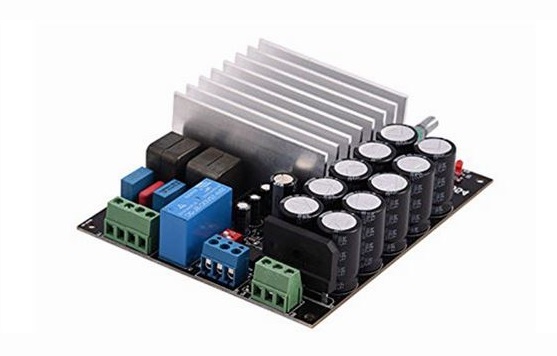An amplifier PCB circuit is a circuit board specially designed for building audio amplifiers or signal amplifiers.Amplifier PCB usually includes the following main parts: amplifier chip, power management, input and output interfaces, and heatsink or thermal design.
(1) Role of amplifier PCB circuit
- Amplification: The PCB can effectively amplify the input signal and increase the power or voltage of the signal to meet various application requirements.
- Efficient Thermal Dissipation: Since amplifiers often operate in high-power environments, the layout of the board needs to be designed with thermal management in mind to prevent components from overheating.
- Reduced Distortion: In order to ensure the clarity of the sound or signal, the design needs to minimize the signal distortion to maintain the original quality of the audio.
Excessive temperatures can cause component failure, and performance degradation, and shorten the life of the device. Thermal dissipation of the PCB can be ensured by the following actions:
(1) Selecting substrates with good thermal conductivity, metal substrates, and ceramic substrates for the PCB;
(2) in the material to determine the appropriate increase in copper thickness to achieve the effect of increased heat dissipation, in the copper thickness increased at the same time PCB hardware designers need to pay attention to increasing the line width line spacing. When the copper increases, in the PCB etching process, etching solutions such as etching concentration, factor, and etching time must be adjusted according to the required thickness. The thicker the copper thickness, the line width, and line spacing should be increased accordingly, otherwise, there will be excessive etching, and side etching problems will be more obvious. This involves PCB layout optimization.
(3) Increase the heat sink and heat sink holes: In the heat element on the heat sink, increase the heat dissipation area to enhance the efficiency of heat release; setting up heat dissipation through holes and blind holes can effectively improve the heat dissipation area and reduce thermal resistance.
(4) Heat sinks with temperature control circuits can be designed to automatically adjust the fan speed or initiate other cooling measures according to temperature changes in the intelligent cooling system.
(5) Thermal connection: A good connection between the heat-generating element and the heat sink can not only improve the contact thermal conductivity but also deal with the effect of thermal expansion on the stability of the structure. Use thermally conductive adhesive or silicone grease between the heat-generating element and the heat sink to reduce thermal resistance and improve thermal conduction efficiency.

In the design and application of amplifier PCB circuit, the focus is on signal integrity, thermal management, category selection, proper combination of devices and materials, and implementation of test verification. As Boeing and electronic devices miniaturize, the demand for amplifier PCB performance continues to increase, and designers need to keep abreast of new technologies and materials to enhance the overall performance of the amplifier. Higher signal quality and thermal management not only improve the reliability of the device but also significantly extend its life.
Amplifiers can be categorized into various classes, such as Class A, Class B, Class AB, and Class D. Each class has its specific characteristics. Each class of amplifier has its specific strengths, weaknesses, and applications. Class A amplifiers are known for their excellent linearity and low distortion and are suitable for hi-fi applications. They provide very clear and precise audio signals and are commonly used in high-end audio amplifiers, radio transmitters, and some professional audio equipment. Class B amplifiers are used in push-pull configurations to improve efficiency and are suitable for use in large sound systems. Class AB amplifiers are commonly used in home audio, car audio, and car audio systems. Amplifiers are commonly used for home audio, car audio, and live audio amplification, and are higher than Class A, typically achieving 50% to 60% efficiency while virtually eliminating crossover distortion. Class D amplifiers can be close to 100% efficient, are suitable for applications with stringent power consumption requirements, and are used in portable stereos, televisions, computer stereos, and car stereo systems, but may generate high-frequency noise that requires the design of an appropriate However, high-frequency noise may be generated, and appropriate filters need to be designed to avoid interference.
Amplifier PCB circuits are often used in the following products:
- Communication equipment: Amplifiers play a vital role in wireless communication and signal transmission.
- Audio systems: Used in home theaters, music speakers, and other high-fidelity audio equipment.
- Medical equipment: Some medical equipment requires high-quality signal amplification for accurate detection and monitoring.